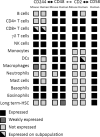Roles of CD48 in regulating immunity and tolerance
- PMID: 26794910
- PMCID: PMC4860950
- DOI: 10.1016/j.clim.2016.01.008
Roles of CD48 in regulating immunity and tolerance
Abstract
CD48, a member of the signaling lymphocyte activation molecule family, participates in adhesion and activation of immune cells. Although constitutively expressed on most hematopoietic cells, CD48 is upregulated on subsets of activated cells. CD48 can have activating roles on T cells, antigen presenting cells and granulocytes, by binding to CD2 or bacterial FimH, and through cell intrinsic effects. Interactions between CD48 and its high affinity ligand CD244 are more complex, with both stimulatory and inhibitory outcomes. CD244:CD48 interactions regulate target cell lysis by NK cells and CTLs, which are important for viral clearance and regulation of effector/memory T cell generation and survival. Here we review roles of CD48 in infection, tolerance, autoimmunity, and allergy, as well as the tools used to investigate this receptor. We discuss stimulatory and regulatory roles for CD48, its potential as a therapeutic target in human disease, and current challenges to investigation of this immunoregulatory receptor.
Keywords: CD244; CD48; SLAM family.
Copyright © 2016 Elsevier Inc. All rights reserved.
Figures



Similar articles
-
CD48: A co-stimulatory receptor of immunity.Int J Biochem Cell Biol. 2011 Jan;43(1):25-8. doi: 10.1016/j.biocel.2010.09.001. Epub 2010 Sep 15. Int J Biochem Cell Biol. 2011. PMID: 20833258 Review.
-
Topology of the CD2-CD48 cell-adhesion molecule complex: implications for antigen recognition by T cells.Curr Biol. 1995 Jan 1;5(1):74-84. doi: 10.1016/s0960-9822(95)00019-4. Curr Biol. 1995. PMID: 7697352
-
Crystal structure and binding properties of the CD2 and CD244 (2B4)-binding protein, CD48.J Biol Chem. 2006 Sep 29;281(39):29309-20. doi: 10.1074/jbc.M601314200. Epub 2006 Jun 27. J Biol Chem. 2006. PMID: 16803907
-
Human b cell differentiation: dependence on interactions with monocytes and T lymphocytes via CD40, CD80 (B7.1), and the CD2-Ligands CD48 and CD58 (LFA-3).Cell Biol Int. 1998;22(1):21-9. doi: 10.1006/cbir.1997.0208. Cell Biol Int. 1998. PMID: 9828079
-
CD48 as a novel target in asthma therapy.Recent Pat Inflamm Allergy Drug Discov. 2007 Feb;1(1):9-12. doi: 10.2174/187221307779815057. Recent Pat Inflamm Allergy Drug Discov. 2007. PMID: 19075961 Review.
Cited by
-
Polygenic autoimmune disease risk alleles impacting B cell tolerance act in concert across shared molecular networks in mouse and in humans.Front Immunol. 2022 Aug 24;13:953439. doi: 10.3389/fimmu.2022.953439. eCollection 2022. Front Immunol. 2022. PMID: 36090990 Free PMC article. Review.
-
Detection of differentially abundant cell subpopulations in scRNA-seq data.Proc Natl Acad Sci U S A. 2021 Jun 1;118(22):e2100293118. doi: 10.1073/pnas.2100293118. Proc Natl Acad Sci U S A. 2021. PMID: 34001664 Free PMC article.
-
Single-cell transcriptome atlas of lung adenocarcinoma featured with ground glass nodules.Cell Discov. 2020 Oct 6;6:69. doi: 10.1038/s41421-020-00200-x. eCollection 2020. Cell Discov. 2020. PMID: 33083004 Free PMC article.
-
CD48 and α7 Nicotinic Acetylcholine Receptor Synergistically Regulate FimH-Mediated Escherichia coli K1 Penetration and Neutrophil Transmigration Across Human Brain Microvascular Endothelial Cells.J Infect Dis. 2019 Jan 9;219(3):470-479. doi: 10.1093/infdis/jiy531. J Infect Dis. 2019. PMID: 30202861 Free PMC article.
-
Interleukin-27-dependent transcriptome signatures during neonatal sepsis.Front Immunol. 2023 Feb 20;14:1124140. doi: 10.3389/fimmu.2023.1124140. eCollection 2023. Front Immunol. 2023. PMID: 36891292 Free PMC article.
References
-
- Calpe S, Wang N, Romero X, Berger SB, Lanyi A, Engel P, Terhorst C. The SLAM and SAP Gene Families Control Innate and Adaptive Immune Responses. 2008;97:177–250. - PubMed
-
- Cannons JL, Tangye SG, Schwartzberg PL. SLAM family receptors and SAP adaptors in immunity. Annual review of immunology. 2011;29:665–705. - PubMed
-
- Staunton DE, Fisher RC, LeBeau MM, Lawrence JB, Barton DE, Francke U, Dustin M, Thorley-Lawson DA. Blast-1 possesses a glycosyl-phosphatidylinositol (GPI) membrane anchor, is related to LFA-3 and OX-45, and maps to chromosome 1q21-23. The Journal of experimental medicine. 1989;169:1087–1099. - PMC - PubMed
-
- Wong YW, Williams AF, Kingsmore SF, Seldin MF. Structure, expression, and genetic linkage of the mouse BCM1 (OX45 or Blast-1) antigen. Evidence for genetic duplication giving rise to the BCM1 region on mouse chromosome 1 and the CD2/LFA3 region on mouse chromosome 3. The Journal of experimental medicine. 1990;171:2115–2130. - PMC - PubMed
-
- Davis SJ, van der Merwe PA. The structure and ligand interactions of CD2: implications for T-cell function. Immunology today. 1996;17:177–187. - PubMed
Publication types
MeSH terms
Substances
Grants and funding
LinkOut - more resources
Full Text Sources
Other Literature Sources
Research Materials
Miscellaneous

